Decoding Paavo Tynell’s Lamp Numbers: The 9000 Series
Paavo Tynell’s lamps carry a distinctive charm, but behind every design is a number that
tells its own story. His model numbers can seem overwhelming at first glance, yet they
reveal patterns that help us understand his work more deeply.
With some exceptions, Tynell models mostly follow a four-digit numbering system, which
helps distinguish them from lamps designed by other designers and produced by other
Finnish manufacturers such as Idman. This consistency makes it easier to identify authentic
Tynell designs, especially those created during his years with Taito.
In this blog, we will focus on the 9000 series, which includes ceiling, table, wall, and floor
lamps. Each group carries its own identity within the broader Taito and Idman catalogues. In
later posts, we will turn to other model groups to complete the picture.
Ceiling Lamps – 90xx Series
These numbers are reserved for Tynell’s ceiling lamps. They range from elegant flush
mounts to elaborate chandeliers, often showcasing brass, perforated metal, and organic
floral details. This series included some of his most iconic lamps including the snowflake and
other leaf and flower motif models.

Examples:
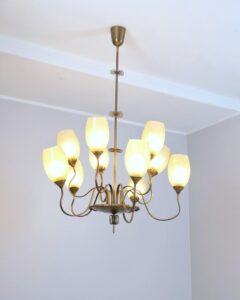
Model 9017 –Brass ceiling lamp with frosted glass shades and spring decorations, c. 1940s.

Model 9053 – “Cannon shell” chandelier with brass and opaline glass shade, c. 1950s.
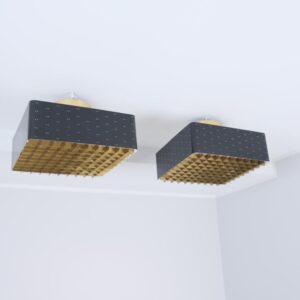
Model 9068 – The iconic starry sky flush mount in brass and perforated painted metal body, c. 1950s

Model 9062 – Monumental chandelier in solid and perforated brass, c. 1950s.
Table Lamps – 92xx Series
The 92xx series covers Tynell’s table lamps, which are among his most versatile and
collectible designs.

Examples:

Model 9227 – Table lamp in brass and painted metal, c. 1950s; one of Tynell’s most iconic desk lamps. c. 1950s
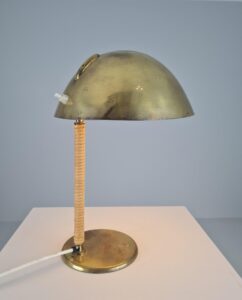
Model 9209 – The Helmet brass table lamp with perforated shade and rattan wrapping c. 1950s
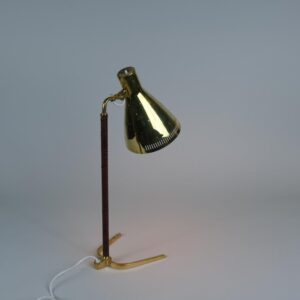
Model 9224 – The iconic horseshoe in brass and leather wrapping c. 1950s.
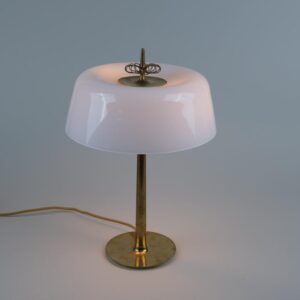
Model 9211 – Elegant and sculptural brass lamp with opaline glass shade, c. 1950s.

Model 9206 – Table lamp combining brass, wood and a rattan or fabric shade. C. 1940s. This model had an earlier model number 5068.
Wall Lamps – 94xx Series
The 94xx group represents Tynell’s wall-mounted lamps. These designs balance function
with elegance and ambience, often used in pairs to frame interiors.

Examples:
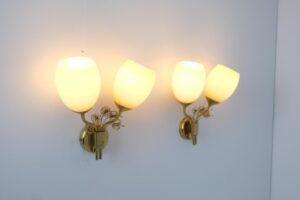
Model 9453 – Brass wall sconce with opaline glass shades and floral decorations, c. 1950s.
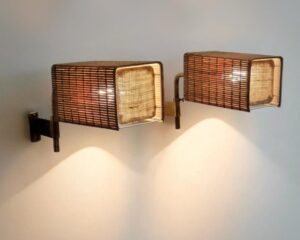
Model 9436 – Adjustable reading or bedside lamp in brass with swing arm and rattan or fabric shades, c. 1940s.

Model 9473 – Classic wall light with floral brass ad crystal decorations with silk shades. C. 1950s
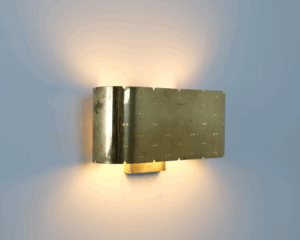
Model 9460 – Bent brass with a perforated decoration. C. 1950s.
Floor Lamps – 96xx Series
The 96xx series includes Tynell’s floor lamps, often tall and slender with distinctive brass
detailing and often with wood, rattan or leather wrapping on stem.

Examples:
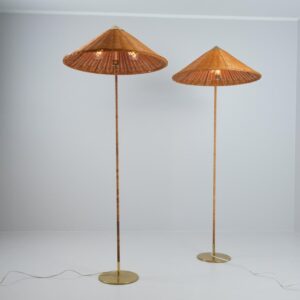
Model 9602 – The celebrated “Chinese Hat” floor lamp with rattan shade. One of Tynell’s most iconic lamps. C. 1940s.

Model 9608 – Brass floor lamp with perforated shade and leather wrapping, c. 1950s.
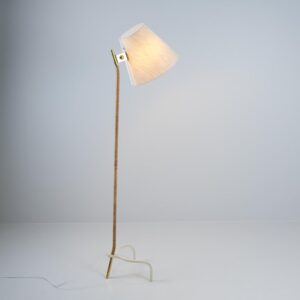
Model 9617 – Rare and mostly by commission floor lamp with sculptural tripod brass base and adjustable fabric shade. C. 1950s.
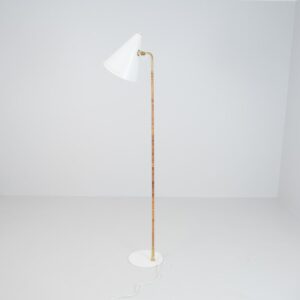
Model 9629 – The “nun’s hat” floor lamp with brass, painted metal shade, and rattan wrapping. c. 1950s.
Numbering Complexities
While the four-digit system makes Tynell’s lamps easier to recognize, it wasn’t always
straightforward:
- Overlapping Numbers: At certain times, the same lamp carried two different model
numbers. Some designs were first given earlier numbers that later changed as
catalogues were updated such as the above example of the table lamp model 5068 /
9206. - Commissioned and U.S. Market Numbers: For commissioned and export,
especially to the United States, models sometimes had separate numbers ranging
from three to five numbers and sometimes combining letters. Also, these lamps often
carried a nickname in the Finland House Catalogue. (This fascinating feature of
nicknames deserves its own blog, which we will cover later.)
Closing Thoughts
The 9000 series gives us just a glimpse into Paavo Tynell’s vast model numbering system.
By understanding how his ceiling, table, wall, and floor lamps were classified, we take an
important step toward unravelling the logic behind his models.
This kind of knowledge is more than a matter of cataloguing — it helps us differentiate
Tynell’s authentic designs from those of other designers and manufacturers, which are
too often mistakenly attributed to him. Each number, each series, brings us closer to a
clearer picture of Tynell’s true legacy.
This blog is just the beginning. In future entries, we will continue to explore other series and
numbering quirks, from overlapping models to U.S. market codes and catalogue nicknames,
all of which add richness to the story of Tynell’s lamps.
Finally, we have launched an Instagram account dedicated entirely to drawings of Paavo
Tynell lamps and will have some exclusive content to help identify rare lamps and some
never seen on the market before. Find and follow us under username @paavo.tynell.lamps
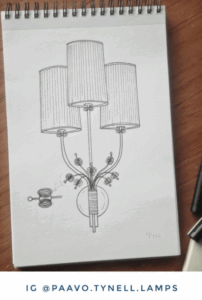
Author: Shadi Haddadin



